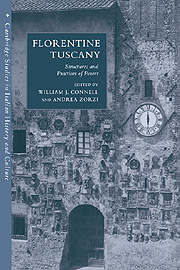Book contents
- Frontmatter
- Contents
- List of figures
- List of tables
- List of abbreviations of archival sources
- Introduction
- 1 The ‘material constitution’ of the Florentine dominion
- 2 The language of empire
- 3 Constitutional ambitions, legal realities and the Florentine state
- 4 Fiscality, politics and dominion in Florentine Tuscany at the end of the middle ages
- 5 Market structures
- 6 State-building, church reform and the politics of legitimacy in Florence, 1375–1460
- 7 The humanist citizen as provincial governor
- 8 Territorial offices and officeholders
- 9 Demography and the politics of fiscality
- 10 Florentines and the communities of the territorial state
- 11 Patronage and its role in government: the Florentine patriciate and Volterra
- 12 San Miniato al Tedesco: the evolution of the political class
- 13 The social classes of Colle Valdelsa and the formation of the dominion (fourteenth–sixteenth centuries)
- 14 Arezzo, the Medici and the Florentine regime
- 15 Rubrics and requests: statutory division and supra-communal clientage in Pistoia
- 16 A comment
- Index
- CAMBRIDGE STUDIES IN ITALIAN HISTORY AND CULTURE
16 - A comment
Published online by Cambridge University Press: 16 September 2009
- Frontmatter
- Contents
- List of figures
- List of tables
- List of abbreviations of archival sources
- Introduction
- 1 The ‘material constitution’ of the Florentine dominion
- 2 The language of empire
- 3 Constitutional ambitions, legal realities and the Florentine state
- 4 Fiscality, politics and dominion in Florentine Tuscany at the end of the middle ages
- 5 Market structures
- 6 State-building, church reform and the politics of legitimacy in Florence, 1375–1460
- 7 The humanist citizen as provincial governor
- 8 Territorial offices and officeholders
- 9 Demography and the politics of fiscality
- 10 Florentines and the communities of the territorial state
- 11 Patronage and its role in government: the Florentine patriciate and Volterra
- 12 San Miniato al Tedesco: the evolution of the political class
- 13 The social classes of Colle Valdelsa and the formation of the dominion (fourteenth–sixteenth centuries)
- 14 Arezzo, the Medici and the Florentine regime
- 15 Rubrics and requests: statutory division and supra-communal clientage in Pistoia
- 16 A comment
- Index
- CAMBRIDGE STUDIES IN ITALIAN HISTORY AND CULTURE
Summary
A first observation is prompted by the wealth of current research on the Florentine territorial state. Gene Brucker, when discussing the present studies, stated that in the 1950s or 1960s a theme like this would have been unthinkable for a conference or a seminar. I can say that the same was true of the beginnings of the 1970s, when Marvin Becker was one of the very few scholars to combine an interest in the territory and the history of the state. Vice versa, when today we survey the field, we encounter a great quantity of work that exists in finished form, numerous scholars who in the past twenty years have worked intensely on the Florentine territorial state, and an even greater number of scholars who are just beginning their work on the subject. They are working, moreover, on themes that until the 1970s were largely ignored and were not comprised in the usual array of subjects traditionally studied by Florentinists. Today, indeed, research on the territorial state makes up the great share of ongoing work in fiorentinistica; and, more importantly, studies on the territory have offered a kind of basic historical perspective that serves to situate all of the quite diverse ongoing research into different aspects of the history of Florence.
- Type
- Chapter
- Information
- Florentine TuscanyStructures and Practices of Power, pp. 333 - 345Publisher: Cambridge University PressPrint publication year: 2000



